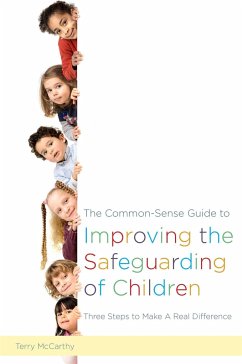Terry Mccarthy
The Common-Sense Guide to Improving the Safeguarding of Children
Three Steps to Make a Real Difference
Terry Mccarthy
The Common-Sense Guide to Improving the Safeguarding of Children
Three Steps to Make a Real Difference
- Broschiertes Buch
- Merkliste
- Auf die Merkliste
- Bewerten Bewerten
- Teilen
- Produkt teilen
- Produkterinnerung
- Produkterinnerung
This book presents a simple and direct three-step approach for developing effective safeguarding practice, providing structured guidance for frontline managers and practitioners.
Andere Kunden interessierten sich auch für
![Safeguarding Children from Abroad Safeguarding Children from Abroad]() Safeguarding Children from Abroad53,99 €
Safeguarding Children from Abroad53,99 €![Improving Children's Services Networks Improving Children's Services Networks]() Marilyn HughesImproving Children's Services Networks49,99 €
Marilyn HughesImproving Children's Services Networks49,99 €![Safeguarding Children in Primary Health Care Safeguarding Children in Primary Health Care]() Safeguarding Children in Primary Health Care51,99 €
Safeguarding Children in Primary Health Care51,99 €![Improving Access to Further and Higher Education for Young People in Public Care Improving Access to Further and Higher Education for Young People in Public Care]() Sonia JacksonImproving Access to Further and Higher Education for Young People in Public Care52,99 €
Sonia JacksonImproving Access to Further and Higher Education for Young People in Public Care52,99 €![Safeguarding Adults Safeguarding Adults]() Suzan CollinsSafeguarding Adults32,99 €
Suzan CollinsSafeguarding Adults32,99 €![Common Sense About Smoking Common Sense About Smoking]() Common Sense About Smoking21,99 €
Common Sense About Smoking21,99 €![Helping Vulnerable Children and Adolescents to Stay Safe Helping Vulnerable Children and Adolescents to Stay Safe]() Katie WrenchHelping Vulnerable Children and Adolescents to Stay Safe35,99 €
Katie WrenchHelping Vulnerable Children and Adolescents to Stay Safe35,99 €-
-
-
This book presents a simple and direct three-step approach for developing effective safeguarding practice, providing structured guidance for frontline managers and practitioners.
Hinweis: Dieser Artikel kann nur an eine deutsche Lieferadresse ausgeliefert werden.
Hinweis: Dieser Artikel kann nur an eine deutsche Lieferadresse ausgeliefert werden.
Produktdetails
- Produktdetails
- Verlag: Jessica Kingsley Publishers
- Seitenzahl: 192
- Erscheinungstermin: 21. Februar 2015
- Englisch
- Abmessung: 226mm x 150mm x 15mm
- Gewicht: 272g
- ISBN-13: 9781849056212
- ISBN-10: 1849056218
- Artikelnr.: 41656900
- Herstellerkennzeichnung
- Libri GmbH
- Europaallee 1
- 36244 Bad Hersfeld
- gpsr@libri.de
- Verlag: Jessica Kingsley Publishers
- Seitenzahl: 192
- Erscheinungstermin: 21. Februar 2015
- Englisch
- Abmessung: 226mm x 150mm x 15mm
- Gewicht: 272g
- ISBN-13: 9781849056212
- ISBN-10: 1849056218
- Artikelnr.: 41656900
- Herstellerkennzeichnung
- Libri GmbH
- Europaallee 1
- 36244 Bad Hersfeld
- gpsr@libri.de
Terry McCarthy is a qualified social worker with over 30 years' experience in children's services. He has held senior management posts and has worked as an independent consultant for social work departments. He now runs Impact for Children Ltd, which provides consultancy and training for local authorities on developing effective safeguarding practice, www.impactforchildren.com.
Introduction. Terminology. 1. Background and Current Environment. 1.1. The
level of need and risk. 1.2. Lessons which have been identified. 1.3.
Attempts to address these lessons. 1.4. The context of safeguarding. 1.5.
The current environment. 1.6. Conclusion: Developing direct effective
safeguarding. 2. Step One: Establish a Culture which Enables and Leads.
2.1. Ensuring that the best interests of children are met. 2.2. Developing
learning and positive change. 2.3. Developing healthy and effective
relationships. 2.4. Styles of authority. 2.5. Responsibility and
accountability. 2.6. Clarity of purpose and performance management. 2.7.
Summary of Step One. 3. Step Two: Develop a Stable, Skilled and Confident
Workforce. 3.1. Emotional challenges, dilemmas and conflicts. 3.2.
Supporting and developing practitioners. 3.3. Practitioner capabilities.
3.4. Manager capability. 3.5. Ensuring safety of practitioners. 3.6.
Developing relationships with partner agencies. 3.7. Summary of Step Two.
4. Step Three: Enable Families to Change. 4.1. Continuous evaluation of
risks and solutions. 4.2. Effective approaches with families. 4.3. Working
with children. 4.4. Summary of Step Three. Appendix A: Checklist for social
workers appraisal based on the PCF capabilities. Appendix B. Additional
skill areas for managers. Appendix C. managing incidents of unacceptable
behaviour. Appendix D. Contents of letters to families to clarify the
nature and expectations of involvement. References.
level of need and risk. 1.2. Lessons which have been identified. 1.3.
Attempts to address these lessons. 1.4. The context of safeguarding. 1.5.
The current environment. 1.6. Conclusion: Developing direct effective
safeguarding. 2. Step One: Establish a Culture which Enables and Leads.
2.1. Ensuring that the best interests of children are met. 2.2. Developing
learning and positive change. 2.3. Developing healthy and effective
relationships. 2.4. Styles of authority. 2.5. Responsibility and
accountability. 2.6. Clarity of purpose and performance management. 2.7.
Summary of Step One. 3. Step Two: Develop a Stable, Skilled and Confident
Workforce. 3.1. Emotional challenges, dilemmas and conflicts. 3.2.
Supporting and developing practitioners. 3.3. Practitioner capabilities.
3.4. Manager capability. 3.5. Ensuring safety of practitioners. 3.6.
Developing relationships with partner agencies. 3.7. Summary of Step Two.
4. Step Three: Enable Families to Change. 4.1. Continuous evaluation of
risks and solutions. 4.2. Effective approaches with families. 4.3. Working
with children. 4.4. Summary of Step Three. Appendix A: Checklist for social
workers appraisal based on the PCF capabilities. Appendix B. Additional
skill areas for managers. Appendix C. managing incidents of unacceptable
behaviour. Appendix D. Contents of letters to families to clarify the
nature and expectations of involvement. References.
Introduction. Terminology. 1. Background and Current Environment. 1.1. The
level of need and risk. 1.2. Lessons which have been identified. 1.3.
Attempts to address these lessons. 1.4. The context of safeguarding. 1.5.
The current environment. 1.6. Conclusion: Developing direct effective
safeguarding. 2. Step One: Establish a Culture which Enables and Leads.
2.1. Ensuring that the best interests of children are met. 2.2. Developing
learning and positive change. 2.3. Developing healthy and effective
relationships. 2.4. Styles of authority. 2.5. Responsibility and
accountability. 2.6. Clarity of purpose and performance management. 2.7.
Summary of Step One. 3. Step Two: Develop a Stable, Skilled and Confident
Workforce. 3.1. Emotional challenges, dilemmas and conflicts. 3.2.
Supporting and developing practitioners. 3.3. Practitioner capabilities.
3.4. Manager capability. 3.5. Ensuring safety of practitioners. 3.6.
Developing relationships with partner agencies. 3.7. Summary of Step Two.
4. Step Three: Enable Families to Change. 4.1. Continuous evaluation of
risks and solutions. 4.2. Effective approaches with families. 4.3. Working
with children. 4.4. Summary of Step Three. Appendix A: Checklist for social
workers appraisal based on the PCF capabilities. Appendix B. Additional
skill areas for managers. Appendix C. managing incidents of unacceptable
behaviour. Appendix D. Contents of letters to families to clarify the
nature and expectations of involvement. References.
level of need and risk. 1.2. Lessons which have been identified. 1.3.
Attempts to address these lessons. 1.4. The context of safeguarding. 1.5.
The current environment. 1.6. Conclusion: Developing direct effective
safeguarding. 2. Step One: Establish a Culture which Enables and Leads.
2.1. Ensuring that the best interests of children are met. 2.2. Developing
learning and positive change. 2.3. Developing healthy and effective
relationships. 2.4. Styles of authority. 2.5. Responsibility and
accountability. 2.6. Clarity of purpose and performance management. 2.7.
Summary of Step One. 3. Step Two: Develop a Stable, Skilled and Confident
Workforce. 3.1. Emotional challenges, dilemmas and conflicts. 3.2.
Supporting and developing practitioners. 3.3. Practitioner capabilities.
3.4. Manager capability. 3.5. Ensuring safety of practitioners. 3.6.
Developing relationships with partner agencies. 3.7. Summary of Step Two.
4. Step Three: Enable Families to Change. 4.1. Continuous evaluation of
risks and solutions. 4.2. Effective approaches with families. 4.3. Working
with children. 4.4. Summary of Step Three. Appendix A: Checklist for social
workers appraisal based on the PCF capabilities. Appendix B. Additional
skill areas for managers. Appendix C. managing incidents of unacceptable
behaviour. Appendix D. Contents of letters to families to clarify the
nature and expectations of involvement. References.








